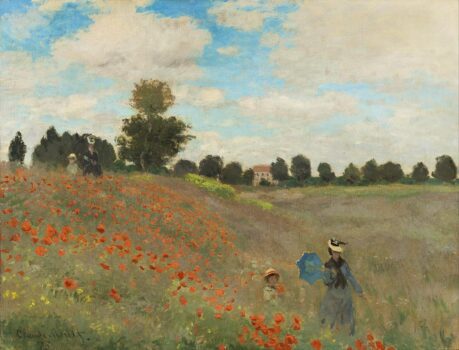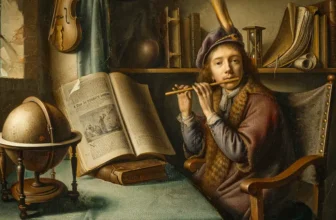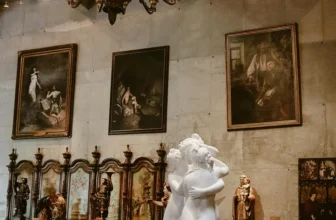Wild Poppies Near Argenteuil Painting by Claude Monet
Shopping Ads: Antique Oil Paintings On Canvas For Sale. Limited Originals Available 💰😊
Authentic hidden masterpieces, Explore old master antique oil paintings from the Renaissance and Baroque eras. From 15th-century to 18th-century Antique Paintings. Bring the Renaissance and Baroque in your home. Shop Now!
🎨 Antique Oil Paintings On Canvas Renaissance, Baroque Art Antique Oil Paintings, Make Offer 16th to 18th Century Portrait Paintings
Claude Monet’s Wild Poppies Near Argenteuil, also known as Poppy Field in Argenteuil, is one of the most beloved and frequently referenced paintings of the Impressionist movement. Painted in 1873, it captures a serene yet vibrant moment in the French countryside and encapsulates many of the principles that define Impressionist art. More than a scenic landscape, the painting is a portal into Monet’s vision, a quiet revolution against traditional academic painting, and a celebration of fleeting moments in nature.
In this comprehensive analysis, we will explore the deeper meaning, symbolism, and artistic innovations in Wild Poppies Near Argenteuil. We will examine what the painting is all about, what is happening within its picturesque frame, and how it reflects Monet’s personal and artistic context. Finally, we will uncover where the painting resides today and how it continues to inspire generations.
Overview of Wild Poppies Near Argenteuil
Painted during a pivotal moment in Claude Monet’s career, Wild Poppies Near Argenteuil is set in the northern French countryside near the town of Argenteuil, where Monet and his family lived for several years. Measuring 50 cm × 65 cm (approximately 20 in × 25.5 in), the painting is executed in oil on canvas and was created in 1873, just one year before the first official Impressionist exhibition in 1874.
The scene is pastoral and deceptively simple: a woman and a child (believed to be Monet’s wife Camille and their son Jean) walk through a field of blooming red poppies. In the background, another pair, likely the same mother and son, are seen further down the hill, creating a visual echo that adds rhythm to the composition. The sky is a soft, cloudy blue, and the green landscape is touched with patches of light and shadow, suggesting the play of sunlight filtering through scattered clouds.
What Is Happening in the Painting?
At first glance, Wild Poppies Near Argenteuil appears to be a leisurely stroll in the grassland. Yet, like many works of Impressionist art, it invites the viewer to look deeper, to notice what is not being said as much as what is visible.
The central action, or rather, the lack of overt action, is a gentle meandering through nature. The woman and child are walking amid the flowers, perhaps collecting poppies or simply enjoying a summer afternoon. The movement is minimal, the gestures soft and flowing. There is a repetition in the figures: one pair is close in the foreground, the other recedes into the distance. This repetition not only creates depth but also introduces a dreamlike quality, as if time is suspended, and moments overlap.
Nothing dramatic occurs, and that is precisely the point. The tranquility, the unspoken bond between mother and child, and the harmony with nature form the heart of the painting. It is an ode to the ephemeral, to the beauty of ordinary moments.
Artistic Style and Technique
Wild Poppies Near Argenteuil is a quintessential example of Impressionism, a revolutionary art movement that rejected the rigid formalism of academic painting in favor of capturing the fleeting effects of light, atmosphere, and everyday life. Monet, a pioneer of the movement, led this shift with works that emphasized perception over perfection, spontaneity over structure.
In this painting, Monet’s brushwork is loose and vibrant. Instead of meticulously blended transitions, he applies color in quick, visible strokes that create texture and energy. The red poppies are not carefully outlined; they are dabs of red that merge and flicker against the green grass. This gives the viewer the impression of movement, as if the flowers are swaying gently in the breeze.
The use of color is masterful. The contrast between the vivid reds and the cooler greens and blues guides the viewer’s eye across the canvas. Monet employs broken color, placing small strokes of different hues side-by-side instead of mixing them, to let the viewer’s eye blend them optically. This technique contributes to the painting’s luminous, shimmering quality.
Symbolism and Interpretation
While Wild Poppies Near Argenteuil is ostensibly a straightforward landscape, it carries layers of symbolic meaning and emotional resonance.
1. The Poppy as a Symbol
Poppies have long been associated with themes of remembrance, sleep, and the transience of life. Although Wild Poppies Near Argenteuil predates the use of red poppies as a World War I memorial symbol, the flower still carries connotations of impermanence. In the painting, the field of poppies could symbolize the fleeting nature of childhood, the ephemerality of beauty, and the passage of time.
By placing his wife and child in the field, Monet adds a personal dimension. It becomes not just a scenic view, but a snapshot of domestic intimacy, a memory frozen in time, perhaps meant to be cherished before it inevitably fades.
2. Harmony with Nature
The painting reflects the Impressionist ideal of being at one with the natural world. Unlike earlier landscape paintings, which often portrayed nature as a dramatic backdrop for mythological or historical events, Monet’s vision is immersive. The figures are not dominating the landscape, they are part of it. The poppies, the grass, the clouds, and the people all flow together in visual and thematic harmony.
This unity speaks to a deeper philosophical stance: that humans are not separate from nature but inherently connected to it. This was a radical idea in a time when industrialization was transforming the world and alienating people from the natural environment.
3. Echoes of Memory and Time
The double appearance of the woman and child invites interpretation. Are they two different people? Or are they the same figures, seen moments apart? This repetition introduces a temporal element into a static medium. It suggests memory, déjà vu, or a poetic rhythm to life’s simple routines.
In this way, Monet’s painting becomes a meditation on time, not time as measured by a clock, but as experienced in quiet, personal moments.
What Is Wild Poppies Near Argenteuil All About?
Ultimately, Wild Poppies Near Argenteuil is about presence. It is about seeing and feeling the world around us in its raw, unfiltered form. It is about noticing the play of light on a summer field, the soft bond between a parent and child, the gentle rhythm of a walk through nature.
Monet’s aim was not to depict a photographic likeness, but to convey a moment’s emotional truth. In doing so, he invites the viewer to slow down, to observe, to appreciate.
The painting is also a testament to Monet’s optimism and his reverence for the natural world. Painted just two years after the Franco-Prussian War, a period of great turmoil for France, Wild Poppies Near Argenteuil offers a vision of peace and healing. It suggests a return to simplicity, to the grounding comfort of the land and family.
Type of Art: Impressionism Defined
As an archetype of Impressionism, Wild Poppies Near Argenteuil challenges traditional definitions of art. Instead of aiming for realism in the academic sense, Impressionist art strives to capture an impression, a sensory experience, a fleeting effect of light, an emotional mood.
Some of the defining characteristics of Impressionism, all present in this painting, include:
Loose, expressive brushstrokes
Focus on light and its changing qualities
Depiction of ordinary subjects
Outdoor settings (plein air painting)
Use of pure, unblended colors
Avoidance of clear outlines and rigid composition
Monet’s method of painting outdoors directly in front of his subject (rather than in a studio) allowed him to capture the nuances of natural light. His process embraced spontaneity and intuition, placing value on personal perception over objective representation.
Historical Context and Personal Relevance
Monet painted Wild Poppies Near Argenteuil shortly after moving to Argenteuil in 1871. This period was especially fruitful for his art, as the region offered an abundance of inspiration: the Seine River, open fields, and changing seasons.
At the time, Monet was financially unstable but creatively invigorated. His wife Camille Doncieux and their son Jean often served as his muses. Including them in the painting added emotional warmth and familiarity, grounding the scene in real life rather than abstract romanticism.
The painting was exhibited at the first Impressionist exhibition in 1874 and was part of the broader movement to challenge the dominance of the French Salon and the rigid hierarchy of classical painting. In that context, Wild Poppies Near Argenteuil was as much a cultural statement as a personal one.
Where Is Wild Poppies Near Argenteuil Located Today?
Today, Wild Poppies Near Argenteuil is housed at the Musée d’Orsay in Paris, France. The museum, which contains one of the world’s most extensive collections of Impressionist and post-Impressionist masterpieces, offers a fitting home for Monet’s iconic work.
The painting remains one of the most visited and celebrated pieces in the museum’s collection. Visitors often linger before it, drawn by its balance of simplicity and depth, its poetic evocation of a moment suspended in time.
The enduring appeal of Wild Poppies Near Argenteuil lies in its timelessness. Though painted over 150 years ago, its themes remain universally resonant. It speaks to the simple joys of life, the comfort of family, and the wonder of nature.
For art historians and students, the painting serves as a textbook example of Impressionist technique and philosophy. For everyday viewers, it is a balm, a reminder to pause, to see, to feel.
Monet’s approach would influence countless artists after him, from his contemporaries like Pierre-Auguste Renoir and Camille Pissarro to later modernists who embraced abstraction, emotion, and personal perspective.
Wild Poppies Near Argenteuil is much more than a charming pastoral scene. It is a work that crystallizes the essence of Impressionism, light, immediacy, and emotional authenticity. Through its delicate composition, symbolic depth, and masterful technique, the painting continues to offer viewers a quiet yet profound meditation on beauty, memory, and presence.
Claude Monet didn’t just paint what he saw, he painted what he felt. And in doing so, he changed the course of art history. In Wild Poppies Near Argenteuil, he invites us to walk with him for a moment in the French countryside and see the world, however briefly, through his eyes.




